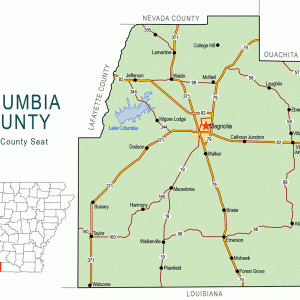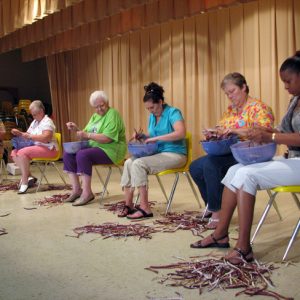calsfoundation@cals.org
Emerson (Columbia County)
| Latitude and Longitude: | 33°05’51″N 093°11’35″W |
| Elevation: | 322 feet |
| Area: | 0.99 square miles (2020 Census) |
| Population: | 293 (2020 Census) |
| Incorporation Date: | March 10, 1905 |
Historical Population as per the U.S. Census:
|
1810 |
1820 |
1830 |
1840 |
1850 |
1860 |
1870 |
1880 |
1890 |
1900 |
|
– |
– |
– |
– |
– |
– |
– |
– |
– |
– |
|
1910 |
1920 |
1930 |
1940 |
1950 |
1960 |
1970 |
1980 |
1990 |
2000 |
|
– |
357 |
373 |
501 |
523 |
350 |
393 |
444 |
317 |
359 |
|
2010 |
2020 |
|
|
|
|
|
|
|
|
|
368 |
293 |
|
|
|
|
|
|
|
|
Emerson is a town on U.S. Highway 79 in southern Columbia County. It is located six miles north of the Arkansas-Louisiana border.
Caddo lived in southern Arkansas when the land was acquired by the United States in the Louisiana Purchase of 1803. The Caddo eventually were removed from Arkansas Territory by treaty, and white settlers began claiming land. The plats of land on which Emerson would be built were purchased by Josiah Daily and Anthony Younger in 1859 and by Moses Moore in 1860.
At the end of the nineteenth century, the Bodcaw Lumber Company built the Louisiana and Arkansas Railroad to move timber to its sawmills. At that time, Reuben Logan Emerson owned land adjacent to land owned by Daily, Younger, and Moore, and he encouraged the creation of a railroad depot and town at that location. Emerson was a member of the Arkansas General Assembly, as well as a teacher, banker, merchant, and owner of the Columbia Banner newspaper. The depot and town were named for him, but while the name “Emerson” was the official designation, many residents of the new town referred to it as “Reuben.” A post office was established in 1898, and the town was incorporated in 1905. Three stores were established, and there were about a dozen business establishments by 1933.
Reuben Emerson’s bank was in Magnolia (Columbia County), but a bank was opened in the town of Emerson in 1905 by Jesse Lee Stevens, Henry Rushton, and Alexander R. Mullins. The Farmers Bank and Trust Company of Magnolia bought out the Bank of Emerson in 1932. A public school district was established, with one building for white students and another for African-American students. Residents of the town also established a Methodist church and a Baptist church. A lumber mill operated in Emerson until the timber was exhausted; by the middle of the twentieth century, the mill had closed. Smaller rural schools were consolidated into the Emerson School District before 1947.
During an election in 1953, a voter quipped that the women of Emerson could do as good a job of running the city council as the men. He prepared a ballot with five of his wife’s friends listed. Between fifty and sixty ballots were cast. After the ballots were officially counted, Ovie Etola Cochran, Gladys Cox, Jennie Bell Foster, Eula Gunnels, and Lurline Stevens were declared duly elected. During the following years, the so-called Petticoat Council arranged a clean-up of property in the town, had Emerson’s dirt roads paved, had streetlights installed, arranged for natural-gas distribution, made improvements to the school property (including a softball field with lighting for night games), and implemented updates to Emerson’s telephone system. During the 1960s, the Emerson School District was desegregated.
In 1990, Glen Eades of Emerson proposed a tiller race for a festival celebrating purple hull peas that was being organized in Emerson that year. The Emerson PurpleHull Pea Festival & World Championship Rotary Tiller Race was held each year the last Friday and Saturday in June on and near the grounds of Emerson High School, offering activities related to purple hull peas, some of which included the World Cup PurpleHull Pea Shelling Competition, the Great PurpleHull Peas & Cornbread Cook Off, the Senior Walk for World Peas, and the presentation of the Emerson PurpleHull Pea Farmer of the Year award. The festival became a success, with an estimated 5,000 people attending each June. The event was held from 1990 to 2023.
With the decline of the timber industry, Emerson became increasingly focused on agriculture, the oil industry, and the bromine industry. The school district was consolidated with those of Taylor (Columbia County) and Bradley (Lafayette County), but each of the three communities continues to support an elementary school and a high school within the consolidated district.
Jim Bailey, Arkansas’s most venerated sportswriter, was raised in Emerson.
For additional information:
Kilgore, Nettie Hicks. History of Columbia County, Arkansas. Magnolia, AR: Magnolia Printing Company, 1947.
MacDuff, Inez Hale. “The Petticoat Council Paved Emerson’s Streets.” Arkansas Democrat Magazine, February 6, 1955, pp. 8–9.
Tubbs, Charlotte. “Tiller Races Churn up Fun.” Arkansas Democrat-Gazette, June 26, 2005, pp. 1B, 10B.
Steven Teske
Butler Center for Arkansas Studies
 Columbia County Map
Columbia County Map  PurpleHull Pea Festival
PurpleHull Pea Festival  PurpleHull Pea Festival Tiller Race
PurpleHull Pea Festival Tiller Race 



Comments
No comments on this entry yet.